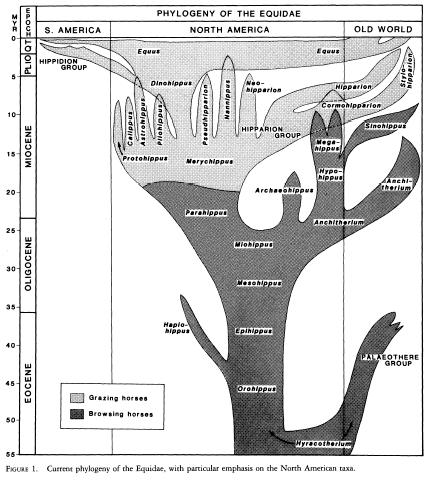
and systematics
| Palaeos: |  |
Evolutionary systematics |
| Phylogeny and systematics |
Evolutionary systematics |
| Page Back | Unit Home | Page Next: Cladistics |
| Unit Back: Phylogeny | Page Up: Phylogeny | Unit Next: Cladistics |
| Phylogeny and Systematics
Systematics - History of ideas Definitions Cladistics Molecular phylogeny A new approach Glossary References |
Evolutionary systematics Grade and Clade |
 Evolution of the Horse diagram from Bruce MacFadden, 1985. "Patterns of Phylogeny and Rates of Evolution in Fossil Horses: Hipparions from the Miocene and Pliocene of North America" Paleobiology, Vol. 11, No. 3. (Summer, 1985), pp. 245-257, retrieved from "Laelaps" blog (Brian Switek), The Branching Bush of Horse Evolution. |
Evolutionary systematics, also known as Evolutionary taxonomy, Evolutionary classification, or Darwinian classification, and Synthetic systematics, is a way to determine natural relationships of organisms by studying a group in detail and comparing degree of similarity. Evolutionary systematics does not have an explicit methodology, but rather relies on the expertise of authorities very familiar with the group in question. This type of taxonomy tends to consider supra-specific taxa rather than single species, so that groups of species give rise to new groups. The concept found its current form in the modern evolutionary synthesis of the early 1940s and stems specially from the work of George Gaylord Simpson and Ernst Mayr. In this school of thought, classification reflects both phylogenetic relatedness as well as morphological disparity (overall similarity). The origin of a major new trait or apomorphy (e.g., flowers in angiosperms, endothermy and lactation in mammals) results in the formation of a new "natural group" of the same Linnaean rank as the "natural" group from which it arose (in these examples gymnosperms and reptiles respectively).
Evolutionary systematics remained the standard paradigm in paleontology and evolution until the 1980s, when it was supplanted by phenetics and especially cladistics.
Both Evolutionary systematics and Cladistics use evolution trees, but differ radically in how the tree is drawn. Where each taxon must consist of a single hypothetical ancestor and all its descendants, phylogeny in evolutionary taxonomy allows for groups to be excluded from their parent taxa (e.g. dinosaurs are not considered to include birds, but to have given rise to them). It assumes that ancestor-descendant relationships can be inferred from nodes on phylogenetic trees and considers paraphyletic groups to be natural and discoverable, and at times designated as ancestors (Mayr 1942). Also includes the default "It doesn't really matter" school of classification (Felsenstein 2003).
Evolutionary systematics often use bubble or balloon or spindle diagrams that map taxonomic diversity (usually mapped on the horizontal axis) against geological time (mapped vertically, in keeping with the geologists' tendency to equate time with geological strata and hence verticality). The classic example of this, frequently reproduced in old textbooks, is the famous evolution of the horse; see above for a recent version. Evolutionary systematics also makes possible the organising of organisms into groups (taxa) and hierarchies of such groups (classification systems), in contrast to cladistic, which instead identifies clades and produces cladograms; so both systems can be correct by their own standards. MAK020520 111014
With the rise of phenetics and statistical methods, evolutionary systematics was criticised for being based on imprecise, subjective, and complicated sets of rules that only scientists with experience working with their organisms were able to use. It was argued that the resulting phylogenies became impossible to reproduce other than by the specialists themselves, and there was a call for more repeatable and objective methods. Following the short lived career of phenetics, which due to its purely quantifiable approach was unable to distinguish between homology and homoplasy, evolutionary systematics was replaced by cladistics and molecular phylogeny. Because of a misunderstanding between the respective functions and methodologies of evolutionary systematics (concerned with actual phylogenies in deep time) and cladistics (concerned with statistically evaluating different phylogenetic hypotheses) it came to be wrongly believed that they were saying the same thing, that evolutionary systematics is a quantifiable result, and cladograms have to describe the actual evolutionary path of life. Such misinterpretations do disservice to both methodologies, but is surely one of the reasons for the decline and fall of evolutionary systematics. Nevertheless, a number of scientists, such as Richard Dawkins, Tom Cavalier-Smith and the authors of Res Botanica, support evolutionary taxonomy, although their criticism of cladistics only applies to literalist cladistics that mistakes cladograms for actual phylogenies. MAK111014
| Page Back/Unit Home | Page Top | Unit Next: Cladistics |
page by M. Alan Kazlev (Creative Commons Attribution 3.0 Unported License)
page uploaded 20 May 2002, last revised MAK111018, edited RFVS111202
checked ATW031208
